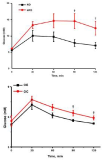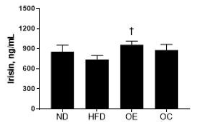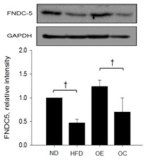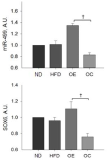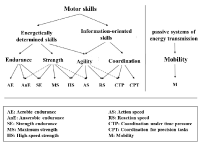
The objective of the present study was to assess muscle fibre composition by non-invasive methods for various sports events. 53 males of marathon (n=5), football (n=22), baseball (n=14), basketball (n=8) and tennis (n=4) athletes volunteered to participate in this study. The following 7 tests (overhead medicine ball throw, pull up, standing broad jump, sit up, shuttle run 10 x5, push up, vertical jump) are relatively easy to perform and to gather information about fibre composition through fitness levels. It can be used to assess the performance of strength using standard tables and to receive an indication of the degree of their share of fast (type II) and slow (type I) muscle fibres. For the study, a data analysis program in Microsoft Excel was used to view the mean and standard deviation of muscle fibre types. As a result, it was possible to speculate that the ratio of muscle fibre types differed according to the type of exercise. The results were obtained after sport motor tests of the mean value of muscle fibre composition by different sports events. Fibre type distribution remained with about 74.8% type 1 and 25.2% type 2 by marathoners, 43.8% type 1 and 53.2% type 2 by football athletes, 36.3% type 1 and 63.8% type 2 by baseball athletes, 46.6% type 1 and 53.5% type 2 by basketball athletes, and 40.0% type 1 and 60.0% type 2 by tennis athletes. Through these tests, the direction of the athletes’ muscle development can be considered, and it is possible to check the muscle fibre composition of elite athletes for the improvement of performance for each sport event. Moreover, it assumes that if this test is used for children, adolescents and young athletes, it will help to design scientific and effective training programs, thereby improving athletes’ ability to perform.

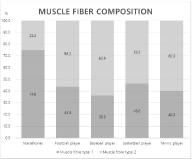
Mental health issues, especially among young women, have significantly increased due to Covid-19 pandemic. Although movement activities in Kinesiology and performing arts can have countless health benefits, physical activity declines drastically among mainly freshmen and young females. The purpose of this study was to examine the effects of physical theater (e.g., dance, aerial dance, calisthenics, strength training, balance, coordination, flexibility, and bodily expression) on mental health, healthy lifestyles, play, and the love of movement among college students. This was a mixed-methods, phronetic and temporal study encompassing quantitative and qualitative data among seven undergraduate students, who enrolled in a physical theater class. Dependent t-tests were conducted to examine differences in depression and stress between the beginning of the class and the end of the semester. Phronetic research was used to analyze the qualitative data and create themes and categories. Mental health improved with a nearly medium within-subject effect for stress (d = .32, Mdifference = 3.5). These data were strengthened by the three emerging themes of the qualitative analysis. The first theme, positive physical theater experiences, included body confidence in expression, improved mental health, healthier lifestyle choices, and the love of movement. The second theme showcased the playful nature of physical theater (e.g., a non-purposeful, interactive, child-like activity, outside ordinary life). A few participants mentioned a couple of negative physical theater experiences (third theme), such as injury and darkness in expression. Movement educators in Kinesiology and performing arts should emphasize safe, bodily, creative, and playful activities within a supportive and community-oriented environment for the promotion of health and the love of movement.

Lateral ankle sprain (LAS) is the most common injury in Korean adolescent soccer players. However, intrinsic risk factors for LAS in adolescent soccer players remain unclear. Therefore, this prospective cohort study aimed to identify intrinsic risk factors for LAS in Korean adolescent soccer players. This study included 100 adolescent soccer players (age=13.21±0.95 years, height=1.62±0.09 m, weight=53.37±9.54 kg, BMI-for-age percentile=63.78±20.89%, athletic career=3.95±1.96 years). Baseline measurements were performed in the preseason, and the injury surveillance on LAS was conducted for 1 year. Independent variables included participants’ demographic and anthropometric data, self-reported questionnaire, lower extremity alignments, range of motion, static, and dynamic balance, coordination, and ankle kinematics during running. Independent t-test and Chi-square analysis were used for potential risk factors, which were imported to the binary logistic regression to identify intrinsic risk factors for LAS. Data on intrinsic risk factors identified by the logistic regression were analyzed using the receiver operating characteristic curve analysis to determine a cutoff point of each variable. In this study, age, body mass index, previous LAS history, the number of LAS history, and maximum dorsiflexion and inversion during the stance phase of running were potential risk factors for LAS. Our major findings showed that decreased dorsiflexion and increased inversion at initial contact during running significantly affected LAS occurrence in Korean adolescent soccer players. Considering our major findings, to prevent LAS in adolescent soccer players, gait training must not be overlooked and should be included in warm-up sessions.


The purpose of this study was to explore key kinematic variables of Yeo Seojeong vault by analysing series of vaults performed by Yeo Seo Jeong (YSJ) in order to provide technical support for YSJ and coaches to develop successful training strategy as well as promote adoption of the technique among gymnasts. Two-dimensional video recordings of YSJ during 2019 Korea Cup (1 successful vault) and practice session (3 unsuccessful vaults) were taken. Phase time, changes in position of body centre of mass, velocity of body centre of mass, and changes in various joint angles, and changes in angular velocity were subjected to kinematic analysis. Kinematic analysis revealed that successful vault was possible when YSJ had fast horizontal velocity at horse touch down as well as fast trunk rotation during horse contact, these allowed her to have faster thigh rotation and take-off angle exceeding 90 degrees at horse take-off resulting to reach maximum height and the length during post-flight. Together with higher and longer post-flight, faster rotation and twisting warranted the successful completion of Yeo Seojeong vault. From the unsuccessful vaults, we found that slow horizontal velocity and bent body posture at board contact as well as low body COM, small horizontal displacement of body COM, and slow vertical velocity at every preparation phase had adverse effect on the horse take-off, i.e. improper blocking, weak propulsion. These resulted rather insufficient post-flight with deceleration of rotation and twisting in descending phase of post-flight leading to insecure landing.
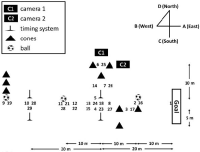
Background Cold application (e.g., lower-leg cooling: LLC) during halftime is becoming more popular in football matches. Therefore, we examined the effects of a 5-min halftime LLC (7.5±1.0℃; bare feet immersed up to the tibial tuberosity), as a recovery strategy on subsequent performance changes in the second-half. Methods Twenty male elite football players (age: 19±1 years; height: 176±6 cm; mass: 69±7 kg; athletic career: 9±1 years) participated in this crossover study (LLC or passive recovery: sitting on a bench without cooling). The 5-min FSP with a fixed intensity and distance, consisted of football-related activities (two trials of sprinting, jumping, dribbling, and kicking in various intensities and distances) and was repeated nine times (total 45-min) to mimic the first- and second-half of a football match. Calorie expenditure, heart rate, athletic performance, and passing accuracy were recorded. To determine feasibility, we compared our data to the normative values in previous reports. To test the condition effects over time, we performed a 2×6 mixed model analysis of variance for calorie expenditure and heart rate. For athletic performance and passing accuracy, we performed a 2×6 mixed model analysis of covariance (covariate: baseline measurement). Results There were no statistical differences between the LLC condition and passive recovery on athletic performance and passing accuracy at any time point (p>0.13 for all statistical tests). Recorded calorie expenditure (1,227±142kcal) and heart rate (163±11bpm) during our FSP were within the normative values of a typical football match (calorie expenditure: 1,200 to 1,500kcal; heart rate: 150 and 175bpm). Conclusions Since a 5-min halftime LLC (at 7.5℃) immersed up to the tibial tuberosity are not effective in delaying fatigue and passing accuracy, it is not recommended for a recovery strategy. Since simulated football matches using the FSP were similar to a typical football match in terms of calorie expenditure and heart rate, it could be used for future research or training purposes.


Obesity is known to be linked with a shift in skeletal muscle fiber type, which plays a role in insulin sensitivity and myokines activity. Here, we investigated whether aerobic exercise training has any effects on skeletal muscle MHC isoforms related to gene expression, irisin, and FNDC5 in obese rats. Thirty-two male SD-rats (3 wks old) were randomly assigned to normal diet (ND, n = 8) and high-fat diet (HFD, n = 24) groups, with specific caloric intake (ND; 11.5%, HFD; 60% of kcals from fat), for 8 weeks. After 8 weeks, HFD-induced obese rats were randomly reassigned to either an obese control (OC, n = 8) or obese exercise (OE, n = 8) group, and provided a normal diet. The OE group was exercised on the rodent treadmill (60 min, 15 m/min, 5 times) for 8 weeks. We investigated FNDC5, slow-twitch muscle gene (miR-499) and fast-twitch muscle gene (SOX6) expression in gastrocnemius muscle, and serum irisin. HFD group showed heavier body weight compared to ND group (p < .05). Blood glucose concentrations, determined by IGTT, were significantly higher in HFD group compared to ND group in 90-minutes and 120-minutes of the recovery phase (p < .05, 43%, 34%). Average body weight for the OE group was significantly lower than the OC group. The level of blood glucose in the OE group was lower than the OC group in 90-minutes and 120-minutes of the recovery phase (p < .05, 11%, 9%). Irisin levels were not significantly different between the HFD and ND groups. However, FNDC5 level was significantly lower in HFD rats than ND (p < .05, 53%). The OE group showed increased expression of irisin and FNDC5 compared to ND, but there was no change in OC (p < .05, 23%, 42%). While the levels of miR-499 and SOX6 were significantly higher in the OE compared to OC group, there was no change in MYH7. Taken together, 8 week regular aerobic exercise has positive effects on body weight, blood irisin concentration, its precursor FNDC5, as well as fiber type promoting genes mi-499 and SOX6.

